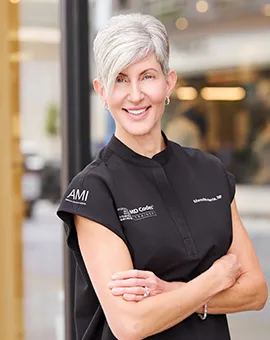Grow your skill set and the success of your aesthetics practice with training from one of the most successful, respected and accomplished leaders in our field, Meredith Harris, MSNP, NP-C.
Tailored specifically to each practitioner’s skill level and needs, the private format of Meredith’s training provides unmatched attention and ensures hands-on, in-depth learning—far superior to the generalized approach found in larger group settings, conferences, or webinars. Personal mentorship with Meredith will deliver faster skill development and individualized feedback that cannot be achieved in larger-scale environments.
Our hands-on approach is a core value, central to our philosophy, allowing practitioners to perform treatments directly under expert supervision. This practical approach instills confidence and mastery, helping practitioners seamlessly integrate new skills into their practice.
Training is available nationwide – either at your location or onsite at New Life Aesthetics in Raleigh NC. Our goal is to provide busy professionals the flexibility to access top-tier education without extensive travel or downtime.
For further information or to inquire about scheduling a personalized training at your facility or onsite at New Life Aesthetics, please email [email protected].
EMAIL US TODAY
Meredith Harris. MSNP, NP-C
Honored Distinguished Woman in Aesthetics 2023 by the American MedSpa Association
Named Leader in Nursing in the American Health Council’s Best in Nursing Category
Meredith Harris is an artist, entrepreneur and Nurse Practitioner with close to two decades of proven medical aesthetic experience. She graduated from the University of Pennsylvania, with an MSNP/NP-C in Nursing & Women’s Health.
Passionate about her profession, she has established several successful aesthetic businesses and has the experience and knowledge to assist other professionals.
Meredith travels the country offering personalized consulting services and hands-on training to providers and their teams, with each training completely customized for their specific needs.
For more information or to inquire about scheduling a personalized training at your facility, please email:
We offer practitioners didactic education for all training modalities, as well as basic or advanced training in Botox®, Xeomin, Dermal Fillers, Kybella®, microneedling, PRF, and more! We also offer consultation pearls, training in account set up with suppliers, retail skincare/sales training, and establishing practice / treatment room set-up, protocols, policies and procedures.
Yes, our training can be customized to include everything from product knowledge and customer service coaching to supplier account support for providers.
Meredith has been wholly devoted to the art of aesthetic medicine for the past 16 years and has operated her own medical aesthetic practice for 10 years. Since opening her practice, she has dedicated at least one day a week to training colleagues throughout the country. She is an international trainer for the leading aesthetic provider, Allergan Aesthetics (makers of Botox, Juvéderm, Kybella, Latisse, SkinMedica, and Coolsculpting). There are only a few hundred professionals with this designation in our industry. She is a key opinion leader, a professional speaker and is passionate about improving outcomes and safety through teaching.
Training is whatever the trainee needs it to be, as it is totally customizable. New Life Aesthetics is set up to be a training site, or Meredith can travel to the location of your practice. She generally recommends that you begin with Toxin training, with a minimum of 4 hours. Together, you would set your goals and schedule for the day, and you would provide a designated number of models that Meredith would approve prior to that day. The first hour is typically didactic, followed by hands-on (which is one-to-one with Meredith). After this training, you will need to be able to immediately begin implementing your skills and practicing in your location.
Once comfortable with your toxin injections, the training can move on to HA filler training. Filler training is typically several sessions, set up much the same, where the focus is on a skillset and the correlating important assessment, anatomy, and safety. For instance, HA filler training with 'cheeks and folds' and then you would become comfortable at home with the implementation of these skills in practice. Then your training would typically advance to 'lips', 'cannulas', 'Kybella/body contouring', 'chin/jawline' etc., etc.
Perhaps you wish to develop greater expertise with injectables, learn how to perform new procedures, or stay up to date on industry trends, including the latest techniques and tools. The outcomes from your training will be determined together, with Meredith’s guidance, to achieve your own individual goals for your practice. In general, you can expect the following outcomes from training and mentorship with Meredith:
For further information or to inquire about scheduling a personalized training at your facility or onsite at New Life Aesthetics, please email [email protected].
EMAIL US TODAY"I was very comfortable & didn't feel inadequate with knowing so little. Meredith was so reassuring & positive which made training with her so easy. My favorite was watching the models face transform & how happy they were & knowing I helped. I'm definitely looking forward to training with her again."
"Meredith is an incredibly thorough educator. She tailors your session based on your personal needs. As a new injector she built my confidence and honed my technique. Highly recommend!" - L.P., ARNP
"Meredith has an extensive knowledge base of all aspects and can teach someone who has even the most extensive experience." - M.C., LPN
"Meredith was knowledgeable and professional. I felt completely comfortable asking any question. After the training I left with new skills and comfort performing them." - A.A., RN
"Meredith is not only highly skilled and knowledgeable but her training style is welcoming and gentle - she is an outstanding trainer!" - J.R., RN
"I loved how Meredith asked questions about my technique- she took the time to better understand what tips/tricks I could add to my technique to better my results" - M.K., RN
"All of my training goals with Meredith were met and I really appreciated learning how to inject the lower face with Botox" - C.S., MD